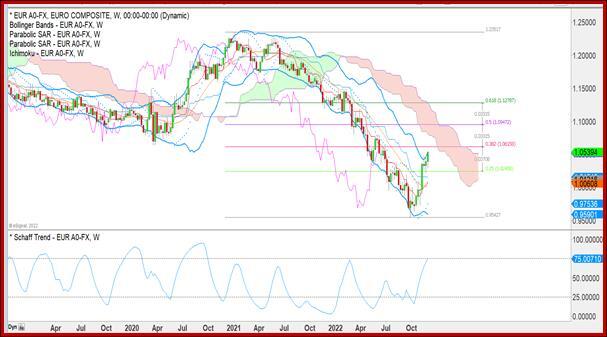Outlook: We get payrolls today, expected lower on the basis of the ADP private sector forecast of a mere 127,000 (and most of that, 100,000, in manufacturing). If payrolls are higher, the dollar can bounce on the somewhat perverse idea that a higher number means the Fed will get more aggressive again, and never mind what Powell said only on Wednesday.
Besides, the consensus forecast is 200,000 (after 261,000 in Oct), so it wouldn’t be hard to get a lower payrolls but still beat the ADP.
This is just one of the many reasons we always warn against trading payrolls. Quick, name the payrolls number that keeps the sentiment status quo. Name the number that drives the dollar down (150?)–where is the line in the sand for the imaginary Fed response? What is the number that gets the markets imagining the next hike is only 25 bp instead of the 50% all but promised by Powell this week (100-125,000)? Alternatively, what is the number that restores 75 bp? In contest, consider that Treading Economics forecasts 210,000.
In practice, there’s not going to be a Fed response. Not directly and immediately, anyway. We guess that the Fed is going to do 50 bp at the next policy meeting regardless of the payrolls number today and where it stands vs. the ADP and the forecast.
TreasSec Yellen was on TV this week and pointed out that up to 1994, the Fed said nothing about policy changes. We had to deduce everything from data like money supply. It’s ironic that these days we get a surplus of Fed commentary and the market still chooses to ignore it, willfully misinterpret it, or overreact to it. We continue to be offended by the lack of semantic imagination that considers a 50 bp rate hike “dovish” simply because it follows a series of four front-loading hikes of 75 bp.
A “weak” payrolls report is reason 1 to imagine a dollar recovery today. Reason 2 is the usual combination of profit-taking and position adjustment on a Friday.
Reason 3 is weak PMI’s and regional Fed indices that smell of looming recession. Even the Atlanta Fed GDPNow for Q4 is a drop from 4.3% before Thanksgiving to 2.8% as of yesterday. The numbers pushing it down include real personal consumption expenditures growth from 4.8% to 3.2%, despite gross private domestic investment growth from 1.0% to 2.0%. Growth in net exports also fell, from 0.64% to 0.16%. .
Reason 4 may well be acknowledgement that China is probably not pivoting on zero-Covid, and all that implies for supply chains.
Bottom line, the dollar drop/euro recovery is as much or more a big position adjustment as a response to economic data or perception of the Fed’s upcoming policy stances. The euro had gotten oversold. See the weekly chart. No one trades a weekly chart, but that’s not the point–the point is that the trajectory of the euro’s fall was getting too steep, accelerating in the past two months, and lasting too long. We don’t even have a 38% retracement yet (1.0616), let alone a 50% retracement (1.0947).
We may get those retracement or may not. The critical observation is that a goodly portion of this countertrend/secondary move is due to position adjustment. And it is itself overly steep, implying its own retreat. Acres of trees may be felled to “explain” the connection between the currency performance and the news, and nearly all of it will be bumpf. The real reason is the feelings of a handful of folks in a handful of trading rooms, nearly all of them good at arithmetic and hardly any of them trained economists. We are reading the mind of the market, not reacting reasonably and responsibly to Facts. We feel compelled to say this from time to time because we so often forget who is actually running this show.
This is an excerpt from “The Rockefeller Morning Briefing,” which is far larger (about 10 pages). The Briefing has been published every day for over 25 years and represents experienced analysis and insight. The report offers deep background and is not intended to guide FX trading. Rockefeller produces other reports (in spot and futures) for trading purposes.
To get a two-week trial of the full reports plus traders advice for only $3.95. Click here!
This morning FX briefing is an information service, not a trading system. All trade recommendations are included in the afternoon report.
Recommended Content
Editors’ Picks
EUR/USD climbs to 10-day highs above 1.0700

EUR/USD gained traction and rose to its highest level in over a week above 1.0700 in the American session on Tuesday. The renewed US Dollar weakness following the disappointing PMI data helps the pair stretch higher.
GBP/USD extends recovery beyond 1.2400 on broad USD weakness

GBP/USD gathered bullish momentum and extended its daily rebound toward 1.2450 in the second half of the day. The US Dollar came under heavy selling pressure after weaker-than-forecast PMI data and fueled the pair's rally.
Gold struggles around $2,325 despite broad US Dollar’s weakness

Gold reversed its direction and rose to the $2,320 area, erasing a large portion of its daily losses in the process. The benchmark 10-year US Treasury bond yield stays in the red below 4.6% following the weak US PMI data and supports XAU/USD.
Here’s why Ondo price hit new ATH amid bearish market outlook Premium

Ondo price shows no signs of slowing down after setting up an all-time high (ATH) at $1.05 on March 31. This development is likely to be followed by a correction and ATH but not necessarily in that order.
Germany’s economic come back

Germany is the sick man of Europe no more. Thanks to its service sector, it now appears that it will exit recession, and the economic future could be bright. The PMI data for April surprised on the upside for Germany, led by the service sector.
